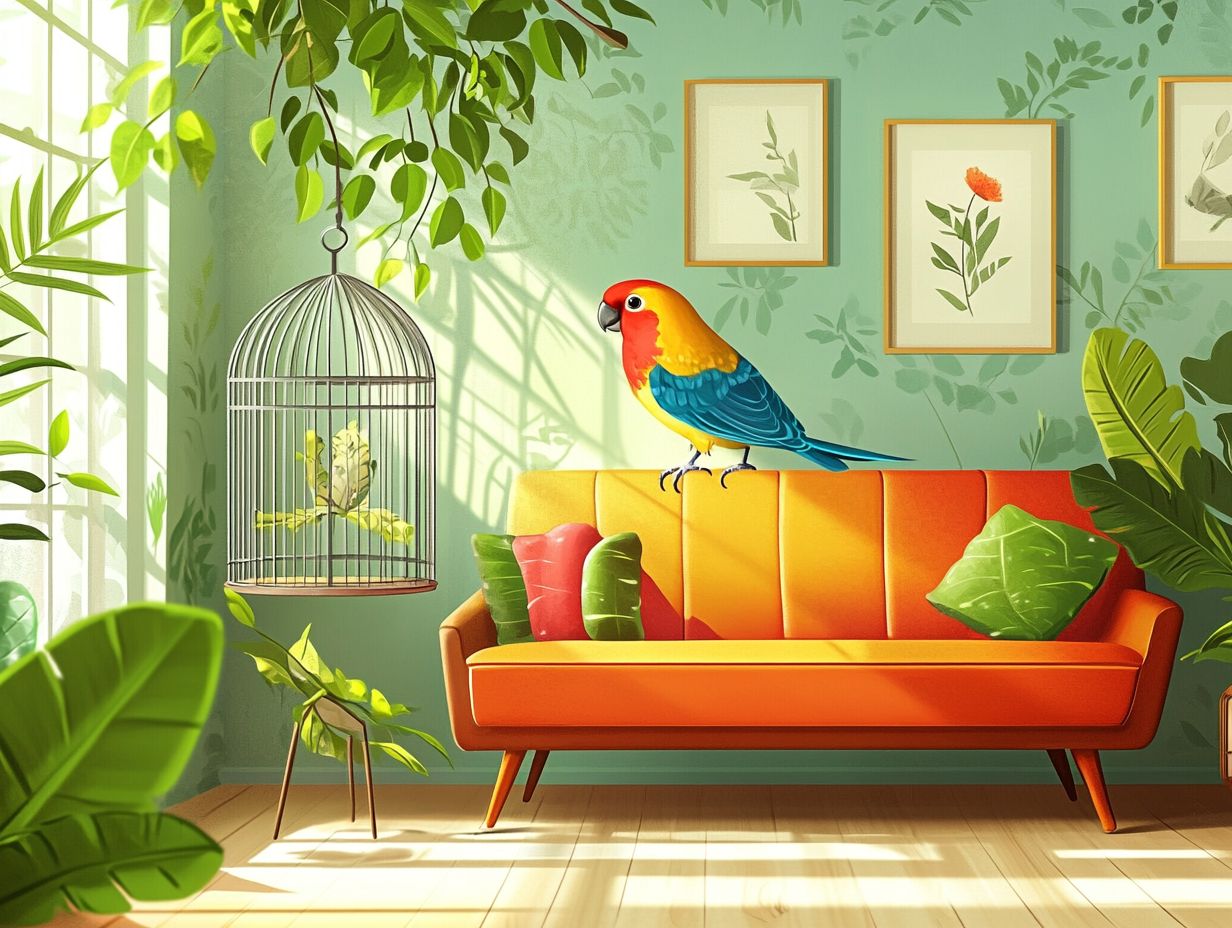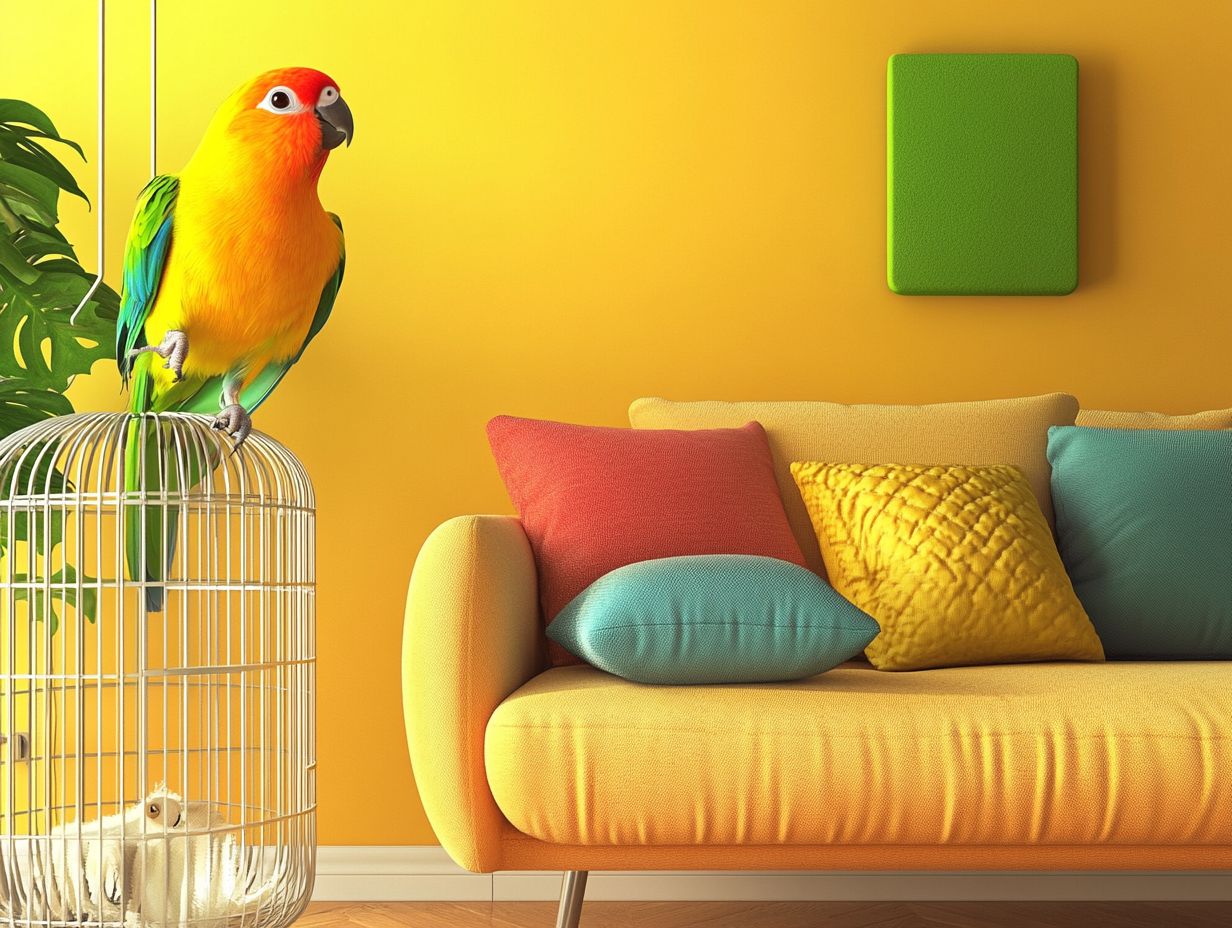How to Minimize Noise from Your Bird?
Birds can undoubtedly bring joy and companionship into your life, yet their vocalizations can sometimes veer into the realm of frustration. Understanding the reasons behind your feathered friend’s noise is the pivotal first step in addressing the issue.
This article delves into common triggers for loud behavior, alongside effective training techniques designed to minimize noise and create a more tranquil environment. You will discover alternative methods, such as the use of white noise and engaging activities, to help manage your bird’s vocal habits. Let s dive into practical strategies to cultivate a peaceful home for both you and your avian companion!
Contents
- Key Takeaways:
- Understanding the Causes of Bird Noise
- Training Techniques to Minimize Noise
- Creating a Quiet Environment for Your Bird
- Alternative Methods for Reducing Bird Noise
- Frequently Asked Questions
- 1. How can I minimize noise from my bird?
- 2. Why is my bird making so much noise?
- 3. Can a bird’s noise level be reduced?
- 4. What are some ways to keep my bird entertained and quiet?
- 5. Is there a particular time of day when my bird will be quieter?
- 6. Are there any specific techniques for training my pet birds to be quiet?
Key Takeaways:

- Training your bird with rewards helps them learn to be quiet!
- Creating a quiet environment with soundproofing solutions can significantly reduce noise.
- Providing enrichment and distractions, like toys and music, keeps your bird occupied and minimizes excessive noise.
Understanding the Causes of Bird Noise
Understanding the causes of bird noise is essential for you as a bird owner. Excessive noise may signal underlying behavioral issues or unmet needs in your beloved cockatoos, macaws, or conures.
Factors like species characteristics, environmental stimuli, and social interactions significantly influence how birds vocalize. This vocalization can range from natural communication to distress signals.
By identifying these causes, you can foster a more harmonious household environment, benefiting both your feathered friends and yourself.
Common Triggers for Loud Behavior
Common triggers for loud behavior in pet birds often arise from environmental factors and species-specific vocalizations that can lead to elevated noise levels in your home.
For example, cockatiels tend to become particularly vocal when they notice changes in their surroundings, like new visitors or shifts in lighting. Budgerigars, in contrast, may respond to your movements, mimicking sounds to engage with you. Lovebirds can also become quite boisterous when they feel bored or neglected, often calling out for interaction to combat their loneliness.
Understanding these nuances helps you manage noise levels and fosters a more harmonious relationship between your feathered friends and your household.
Training Techniques to Minimize Noise
Training techniques designed to minimize noise in pet birds are essential for creating a serene living environment. These methods focus on positive reinforcement and changing behavior.
By employing rewards and targeted training approaches, you can effectively manage vocalizations in species such as cockatoos, conures, and parrotlets. Customized training strategies can lead to remarkable improvements in the behaviors exhibited by your feathered companions.
Positive Reinforcement and Changing Behavior

Positive reinforcement and changing behavior are powerful techniques that can significantly reduce noise levels in your pet birds by encouraging the behaviors you want through rewards. These methods involve offering treats, praise, or playtime as incentives for your birds to demonstrate calmer behaviors.
For example, when your bird stays quiet for a certain period, rewarding them with their favorite fruit reinforces that positive behavior. Clicker training can also work wonders; the sound of the clicker serves as a cue that your bird has done something right, followed by a reward.
Consistency in these techniques is essential, helping your bird grasp the connection between their actions and the rewards they receive. Supervision during training sessions is crucial to ensure you’re rewarding the desired behaviors and not inadvertently reinforcing any unwanted noise-making actions.
Start today for a more peaceful home with your beloved bird!
Creating a Quiet Environment for Your Bird
Creating a cozy, quiet space makes your birds happier and healthier! A tranquil environment for your bird requires a thoughtful blend of soundproofing solutions, suitable materials, and an emphasis on comfort within their living space.
This holistic approach enhances the well-being of your pet birds, whether they are cockatiels, macaws, or parrotlets.
Incorporating soundproofing materials like acoustic foam and heavy vinyl sheets can dramatically reduce noise levels. Ensuring proper airflow and comfort is essential for cultivating a truly healthy habitat.
Soundproofing Solutions
Effective soundproofing solutions are essential for creating a serene environment for your pet birds. Use materials that absorb or block noise while ensuring their living spaces remain comfortable.
Employing various techniques can significantly reduce stress levels for your feathered companions. Consider mounting acoustic panels on walls to absorb sound waves and minimize echo.
Installing mass-loaded vinyl barriers dense yet flexible will block out external noise, creating a tranquil atmosphere.
These soundproofing solutions enhance your birds’ quality of life by alleviating anxiety from loud disturbances and fostering a peaceful setting for bonding and interaction. Ultimately, this benefits both your birds and yourself, promoting overall well-being.
Alternative Methods for Reducing Bird Noise
You might explore alternative methods for reducing bird noise by incorporating white noise or music into their environment.
Providing enrichment and distractions can significantly enhance your pet bird’s quality of life while minimizing excessive vocalizations.
Using White Noise or Music

Using white noise or music as background sounds can significantly reduce excessive noise from your pet birds, creating a serene environment while allowing their natural vocalizations to shine through.
Thoughtfully choosing the right ambient sounds can diminish the disruptive impact of sudden squawks or chirps that might interrupt your daily activities. Incorporate soft instrumental music or gentle nature sounds, like flowing water and rustling leaves; these can be particularly soothing.
Incorporating these sounds into their cage is easy simply play a calming Spotify playlist or use a white noise machine. This strategy fosters a sense of security for your birds and enhances the overall atmosphere of your home, promoting tranquility for both your feathered friends and yourself.
Providing Enrichment and Distractions
Providing enrichment and distractions is vital for keeping your pet birds mentally stimulated, leading to reduced noise levels and improved behavior.
Engage your feathered friends with a variety of activities and toys to enhance their overall well-being. Interactive toys, like puzzle feeders, not only challenge their intellect but also reward them with treats, turning the experience into a delightful game.
Swings and climbing structures offer opportunities for physical activity, boosting their coordination and strength. Regularly rotating these items keeps their environment fresh and exciting, encouraging exploration and interaction.
By fostering these enriched interactions, you can help alleviate common behavioral issues, such as excessive vocalization, creating a more peaceful and harmonious household.
Frequently Asked Questions
1. How can I minimize noise from my bird?
Here are a few steps you can take to minimize noise from your bird:
- Provide mental stimulation.
- Create a calm environment.
- Train your bird for quiet behavior.
2. Why is my bird making so much noise?

Birds are talkative and use their voices to communicate. In the wild, they call to stay in touch with their flock. In captivity, they might make noise because they are bored, stressed, or seeking attention.
3. Can a bird’s noise level be reduced?
Some birds are quieter by nature, but you can train your bird to be less noisy. This training requires patience and consistency from you.
4. What are some ways to keep my bird entertained and quiet?
Give your bird a variety of toys and activities to keep their mind engaged. Rotating toys regularly will help maintain their interest.
5. Is there a particular time of day when my bird will be quieter?
Many birds enjoy being active and vocal in the morning and evening. If your bird is noisy at these times, engage them in activities to help keep them occupied.
6. Are there any specific techniques for training my pet birds to be quiet?
One effective technique is positive reinforcement. Reward your bird when they are quiet. You can use a “quiet” command and give them a treat when they stop making a lot of noise. Creating a comfortable environment with sound-absorbing materials can also help manage noise levels.






